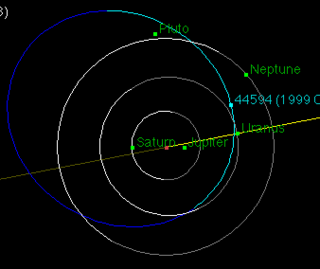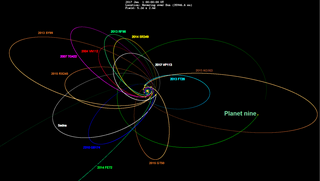(118228) 1996 TQ66, prov. designation:1996 TQ66, is a resonant trans-Neptunian object of the plutino population in the Kuiper belt, located in the outermost region of the Solar System. It was discovered on 8 October 1996, by American astronomers Jun Chen, David Jewitt, Chad Trujillo and Jane Luu, using the UH88 telescope at the Mauna Kea Observatories, Hawaii. The very red object measures approximately 185 kilometers (110 miles) in diameter. As of 2021, it has not been named.

(44594) 1999 OX3 is an eccentric trans-Neptunian object with a centaur-like orbit from the outer Solar System, approximately 150 kilometers in diameter. It was discovered on 21 July 1999, by astronomers John Kavelaars, Brett Gladman, Matthew Holman and Jean-Marc Petit at Mauna Kea Observatories, Hawaii, United States.
(181902) 1999 RD215 is a trans-Neptunian object of the scattered disc, approximately 148 kilometers in diameter. It was discovered on 6 September 1999, by American astronomers Chad Trujillo, Jane Luu, and David Jewitt at the Mauna Kea Observatories, Hawaii.
(469306) 1999 CD158, provisional designation: 1999 CD158, is a trans-Neptunian object from the circumstellar disc of the Kuiper belt, located in the outermost region of the Solar System. The relatively bright hot classical Kuiper belt object measures approximately 310 kilometers (190 miles) in diameter. It was discovered on 10 February 1999, by American astronomers Jane Luu, David Jewitt and Chad Trujillo at Mauna Kea Observatories on the Big Island of Hawaii, United States.
(589683) 2010 RF43, provisionally designated: 2010 RF43, is a large trans-Neptunian object orbiting in the scattered disc in the outermost regions of the Solar System. The object was discovered on 9 September 2010, by American astronomers David Rabinowitz, Megan Schwamb and Suzanne Tourtellotte at ESO's La Silla Observatory in northern Chile.
(445473) 2010 VZ98, provisional designation 2010 VZ98, is a trans-Neptunian object of the scattered disc, orbiting the Sun in the outermost region of the Solar System. It has a diameter of approximately 400 kilometers.
1999 TR11, is a resonant trans-Neptunian object from the Kuiper belt, located in the outermost region of the Solar System. The reddish plutino measures approximately 93 kilometers (58 miles) in diameter. It was first observed on 9 October 1999, by American astronomer Scott Sheppard at the Mauna Kea Observatories with the University of Hawaii's 2.2-meter telescope.
2013 GP136 is a trans-Neptunian object from the scattered disc in the outermost reaches of the Solar System, approximately 212 kilometers in diameter. It was discovered on 8 February 2013, by the Outer Solar System Origins Survey at the Mauna Kea Observatories on the island of Hawaii, United States.

2015 GT50, previously known as o5p060, is a trans-Neptunian object orbiting in the Kuiper belt of the outermost Solar System. It was first observed by the Outer Solar System Origins Survey using the Canada–France–Hawaii Telescope at Mauna Kea on 13 April 2015.

2015 KG163, also known as o5m52, is a trans-Neptunian object from the outermost region of the Solar System, approximately 102 kilometers (63 miles) in diameter. It was first observed on 24 May 2015, by astronomers of the Outer Solar System Origins Survey using the Canada–France–Hawaii Telescope at Mauna Kea Observatories, Hawaii, United States. With an observation arc of 2 years, it passed perihelion around August 2022 at a velocity of 6.5 km/s with respect to the Sun.
(505478) 2013 UT15 is an extreme trans-Neptunian object from the scattered disc, located in the outermost regions of the Solar System, approximately 260 kilometers (160 miles) in diameter. It was discovered on 2 August 2013, by astronomers of the Outer Solar System Origins Survey at Mauna Kea Observatory, Hawaii, United States.
2015 RY245, also known as o5s13, is a trans-Neptunian object from the scattered disc of the outermost reaches of the Solar System, approximately 78 kilometers in diameter. It was discovered on 9 September 2015, by the Outer Solar System Origins Survey using the Canada–France–Hawaii Telescope at Mauna Kea Observatories, Hawaii, United States.
2015 KH163, is a trans-Neptunian- and scattered disc object from the outermost region of the Solar System, approximately 117 kilometers in diameter. It was first observed by astronomers during the Outer Solar System Origins Survey at the Mauna Kea Observatories on 24 May 2015.
2005 RH52 is an extreme trans-Neptunian object from the extended scattered disc in the outermost region of the Solar System, approximately 130 kilometers (81 miles) in diameter. It was first observed on 3 September 2005, by astronomers with the Canada–France Ecliptic Plane Survey using the Canada–France–Hawaii Telescope at the Mauna Kea Observatories in Hawaii, United States.
(506479) 2003 HB57, is an extreme trans-Neptunian object of the extended scattered disc in the outermost region of the Solar System, approximately 180 kilometers in diameter. It was discovered by astronomers at the Mauna Kea Observatory on 26 April 2003.

2013 FS28 is an extreme trans-Neptunian object from the extended scattered disc on a highly eccentric orbit in the outermost region of the Solar System. It measures approximately 466 kilometers (290 miles) in diameter. The detached, extended scattered disc object belongs to the group of extreme trans-Neptunian objects. It was first observed on 16 March 2013, by American astronomers Scott Sheppard and Chad Trujillo at the Cerro Tololo Observatory in Chile.
(527603) 2007 VJ305, provisional designation 2007 VJ305, is an extrem trans-Neptunian object from the extended scattered disc on a highly eccentric orbit in the outermost region of the Solar System. It measures approximately 250 kilometers (160 miles) in diameter and is "possibly" a dwarf planet. The rather reddish extended scattered disc object belongs to the group of extreme trans-Neptunian objects. It was discovered on 4 November 2007 by astronomers Andrew Becker, Andrew Puckett and Jeremy Kubica at the Apache Point Observatory in New Mexico, United States.
2013 UH15 is an extreme trans-Neptunian object from the extended scattered disc in the outermost region of the Solar System, approximately 130 kilometers (81 miles) in diameter. It was first observed on 29 October 2013, by astronomers at the Las Campanas Observatory in the southern Atacama Desert of Chile. The detached extended scattered disc object (ESDO) is on a highly eccentric orbit and belongs to the extreme trans-Neptunian objects.
2015 FJ345 is a trans-Neptunian object and detached object, located in the scattered disc, the outermost region of the Solar System. It was first observed on 17 March 2015, by a team led by American astronomer Scott Sheppard at the Mauna Kea Observatories, in Hawaii, United States. With its perihelion of almost 51 AU, it belongs to a small and poorly understood group of very distant objects with moderate eccentricities. The object is not a dwarf planet candidate as it only measures approximately 120 kilometers (75 miles) in diameter.
(505448) 2013 SA100, provisional designation 2013 SA100 and also known as o3l79, is a trans-Neptunian object from the classical Kuiper belt in the outermost region of the Solar System. It was discovered on 5 August 2013, by astronomer with the Outer Solar System Origins Survey at the Mauna Kea Observatories, Hawaii, in the United States. The classical Kuiper belt object belongs to the hot population and is a weak dwarf planet candidate, approximately 260 kilometers (160 miles) in diameter.




